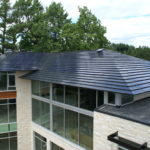Adding module-level power electronics (MLPE) to residential rooftop solar projects to comply with the latest rapid shutdown requirements may not typically add too much time or labor to installations. But that rooftop safety requirement isn’t just for residential homes — commercial rooftops require the same treatment.
C&I installers these days install rooftop projects in sizes comparable to their ground-mount counterparts — for example, PowerFlex recently completed the country’s current largest rooftop community solar project, clocking in at 9.2 MW. The team had to install one rapid shutdown device (RSD) for every two of the 22,320 solar modules on the roof.
But PowerFlex wasn’t daunted when NEC 2017 created that requirement. The company had already started installing SolarEdge power electronics on its commercial rooftop projects before that time. The string-inverter-plus-optimizer solution gave designers more flexibility for maximizing PV coverage on irregular roof surfaces — ensuring that if any modules experience shading or limited performance from dust and grime buildup, the rest of the array isn’t affected.
“When you’re freed up as a designer to have multiple string lengths because of the inherent flexibility in optimizer technology, that’s a big advantage,” said Pete Vash, technical director for PowerFlex. “When optimizers became available to the marketplace, folks who were doing commercial roofs were very interested in them even before there were rapid shutdown requirements just because of the improved production and the design flexibility.”
Once NEC 2017 was adopted by many jurisdictions, SolarEdge optimizers fit the requirements of lowering voltage to 80 V or less within 30 seconds. PowerFlex is technology-agnostic, but these days, the company uses SolarEdge for most systems.
“We had something that was working and we were able to continue with the same sort of design that we had,” Vash said. “They’ve been a good partner for PowerFlex and they’ve supported projects during the commissioning process, so there’s good synergy there.”
Along with optimization, SolarEdge touts the safety benefits of its inverter solution. If any installation errors are made, SolarEdge says its temperature-sensing software will catch it.
“Our technology has that module-level visibility that we can see. We can even see a blown bypass diode on the module. We can see that there’s a fault. We have sensors that are detecting it, they’re reporting it, and that means people can fix it,” said Carolyn Humphreys, C&I sales manager for Eastern North America at SolarEdge.
SolarEdge also stands by its offering for the foundational architecture. Instead of distinct entities set up to work together as an afterthought, its technology is part of one cohesive system.
“We feel there’s a huge advantage to having everything integrated as a system from a single vendor,” said Jason Bobruk, director of code compliance at SolarEdge. “And we also maintain the reliability and robustness of that system through our quality control programs, and all of this philosophy translates into our certification approach too. When we certify a rapid shutdown system, we certify as a whole, entire system— [that] includes the optimizers, includes the inverters, even includes the little DC-disconnect enclosure with the switch on it.”
Struggles of streamlining shutdown
Whatever an installer’s rapid shutdown equipment choice may be, installing hundreds or thousands of additional components on a project comes with its inherent downsides. It takes more time to prep all the gear, install each unit and commission them. Perhaps the bigger headache, though, is the added O&M stress when adding in many extra potential failure points in a project.
“Adding optimizers may result in unexpected costs when you’re running an operating asset,” said Matt Cote, senior procurement manager at PowerFlex. “Even if the components hypothetically have a 0.1% failure rate, when you’re deploying thousands of them, it does add up over time and potentially causes a lot of different challenges.”

A commercial installation on Clif Bar’s rooftop by Sun Light & Power uses Tigo MLPE to satisfy rapid shutdown requirements.
Tigo Energy is another major MLPE manufacturer that’s UL-certified as a rapid shutdown system with numerous inverter brands. The company recently announced an inverter of its own as well. Tigo offers three variations of rapid shutdown-satisfying MLPE — standalone RSD, RSD plus monitoring and RSD plus monitoring and optimization. Since pricing is ultra-competitive in C&I projects, Tigo’s chief marketing officer James Dillon said most installers currently choose RSD alone to save the extra $10 or so per unit.
“That is a shame, because that is a trade-off between [operating expenses] and cost — how much work do you want to put in up-front vs. the long-term operation and maintenance? I believe that we need to do a better job explaining the value and having a great software solution that the installers will get the most out of,” he said.
Illinois-based GRNE Solar installs commercial projects across the Midwest, where some permitting offices are still using the 2014 NEC. The companywide stance is that safety comes first, so GRNE believes module-level rapid shutdown should be implemented regardless of the area’s code adoption. The company has run into some pushback on that philosophy from developers.
“The cost increase for the material and installation can be a significant adder to a project’s overall budget. When considering a competitive RFP, it is not always an apples-to-apples comparison when rapid shutdown is not included on every contractor’s bid submission,” said Jeremy Hoerauf, commercial project manager for GRNE Solar, in an email.
Another common problem is it’s sometimes unclear who’s responsible for O&M for the lifetime of these commercial projects, Tigo’s Dillon said. If it’s not the installer, they have even less incentive to opt for the more-costly monitoring solution. But he expects the present-focused nature of the market to shift as rapid-shutdown-enabled systems begin to age.
“The bill doesn’t come due until a few years in, so if someone is having problems with installations they did three, four, five, eight years ago, they’re going to learn from that and build it into the future,” Dillon said.
Connector conundrum
Another stressor that surfaces when adding hundreds of additional components between the module and inverter is the hundreds of additional PV connectors required to install them. At this time, there is no universal standard for PV connectors, but the latest code requires all connectors used on a product to be the same — either made by the same manufacturer or UL-tested to be compatible. This means companies are often scrambling to source enough connectors from one maker, with varying results.
“It might sound like that’s a trivial matter, but can you imagine if all USBs were not created equal and every laptop had a slightly different-sized connector?” Vash said.
GRNE expressed the same complaint after running into some connectors that aren’t compatible with either its selected modules or rapid shutdown units.
“What we’d like to see from rapid shutdown manufacturers is a standard connector that works for any module manufacturer,” Hoerauf said. “With the industry moving toward each module manufacturer having their own connector, the rapid shutdown suppliers must standardize the connector and get it approved for all modules.”
The installer has also noticed the module industry is moving toward shorter wire leads, so the RSD makers need to start creating longer leads to connect to them. These logistical issues may seem small but can lead to cumbersome delays that harm business.
Simplifying MLPE offerings
Since the rapid shutdown requirement is relatively fresh, new products and advancements are rolling out quickly to satisfy the need. Cote said the major pain point he hopes manufacturers will address is the complexity of companies having to source and install different components from multiple makers. Package deals with pre-assembled components and integrated RSDs can save installation teams time on-site.
“If companies on the supplier side are innovating and working together to make something that is just a full package for a company like us, that would be super beneficial and would take out a lot of the guesswork and the headaches around designing,” he said.
But that kind of collaboration is not easy in an industry where technology is rapidly changing.
“The challenge with that is there’s so many different options out there,” Tigo’s Dillon said. “We actually are compatible with hundreds of inverter options — you have to do it with each and every size at each and every manufacturer. It’s an endless upgrade battle.”
So Tigo is pursuing a different route to simplify their devices for installers. Engineers are working to condense their MLPE into one device and use hardware to enable the different functions rather than offer the attributes of RSD, monitoring and optimization in three different devices. That hardware-enabled device would also eventually, ideally, receive other updates digitally.
“That would make it even easier — if you could put one piece of hardware and say, ‘I want optimization on this half of the building, and on this half I just need rapid shutdown because there’s no chance of shade,’” Dillon said.
As a relatively new requirement, module-level rapid shutdown wrinkles are still being ironed out, especially on large-scale commercial rooftop projects. In the meantime, installers will have to keep learning best practices as they go to make both installation and ongoing maintenance as easy as possible.











Tell Us What You Think!